UL 969 is a critical standard for labeling and marking systems. More specifically, UL 969 is the standard for adhesive-backed labels that are used for permanent product identification.
There are specific labeling requirements, certification processes, and categories under UL 969, developed to ensure durability and reliability in labeling practices for products.
Whether you’re a manufacturer, a product designer, or simply interested in the standards of product labeling, this article offers a thorough overview of UL 969’s role in maintaining quality and consistency in labeling systems.
In This Article:
Sometimes referred to as ANSI 969, UL 969 is the standard for labels and markings. Items produced under this standard are pre-qualified and tested by Underwriters Laboratories (UL) for durability. Specifically, UL 969 is the standard for marking and labeling systems used for permanent product identification.
Generally, these types of labels are nameplates that are applied to devices, appliances, and equipment that contain rating information, instructions, and schematics. The labels also may include safety-related information such as hazards, warnings, cautionary markings, electrical ratings, and installation instructions.
UL 969 labels are essential for ensuring critical safety information remains attached and legible on various UL listed and recognized products. Whether or not a UL 969 label is needed is crucial for manufacturers: if a label carries important safety information or technical product information, it’s likely that UL 969 compliance is necessary.
A review of the product procedure documents or the relevant UL standard can provide definitive answers.
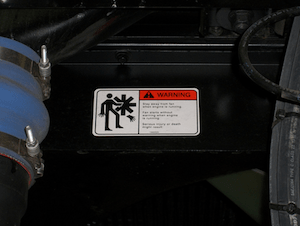
The requirements in UL 969 apply to unprinted materials such as blank label stocks, over-laminations, laminating adhesives, and screen-printable adhesives that will become finished labels. They also cover specific combinations of label material, ink, and printing processes, as well as labels that are intended to be mechanically attached or molded into a plastic part.
UL 969 Standards for Marking and Labeling also cover pressure-sensitive, heat-activated, or solvent-activated adhesive labels that may contain text or pictographs.
According to the UL 969 Standards: “marking and labeling systems are evaluated for specific uses and for application to specific surface materials that are essentially smooth, flat, and rigid unless another surface configuration is specified by the manufacturer.”
It’s a misconception that all labels on a product need to be UL- approved. Only labels serving a functional role, such as those carrying serial numbers, model numbers, instructions, warnings, etc., require UL 969 approval under the component label program.
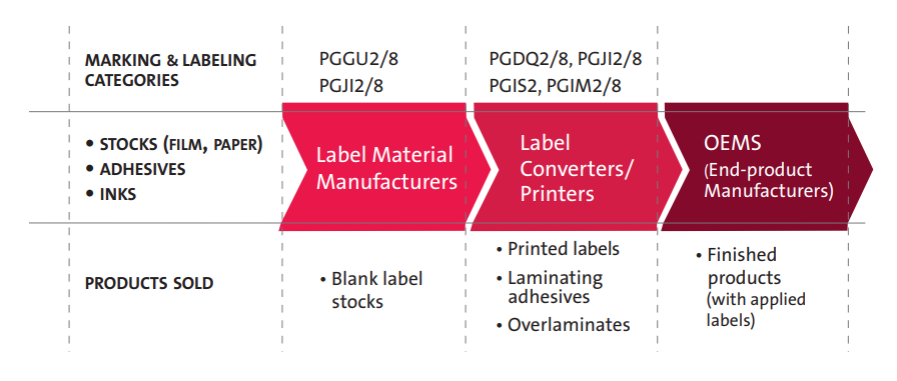
Screenshot via UL Solutions
A critical aspect of UL 969 is the label construction and components. The complete label construction, including adhesive, facestock, ink, lamination, and secondary ink, plays a vital role in meeting UL 969 standards. It’s important to note that individual components’ UL 969 approval does not automatically imply the complete label construction’s approval.
Within UL 969, labels are categorized under different Category Code Numbers (CCNs), such as PGDQ2, PGJI2, PGIM2, PGGU2, and PGIS2, each catering to specific standards and applications.
Primary printing refers to printing done by a third-party manufacturer, and secondary printing is the print added by the end user. In both cases, the label materials and construction, including all printing inks, must be tested and approved by UL.
For secondary printing, the end user must use only the approved ribbons or toner cartridges specified in the UL directory.
Secondary printing rules state that the printing method and ink system must be pre-approved for labels allowing additional information post-manufacturing, such as lot codes or dates. This ensures the label’s long-term legibility and compliance.
Furthermore, core labels play a crucial role in compliance verification during inspections, as they are considered recognized components under UL 969.
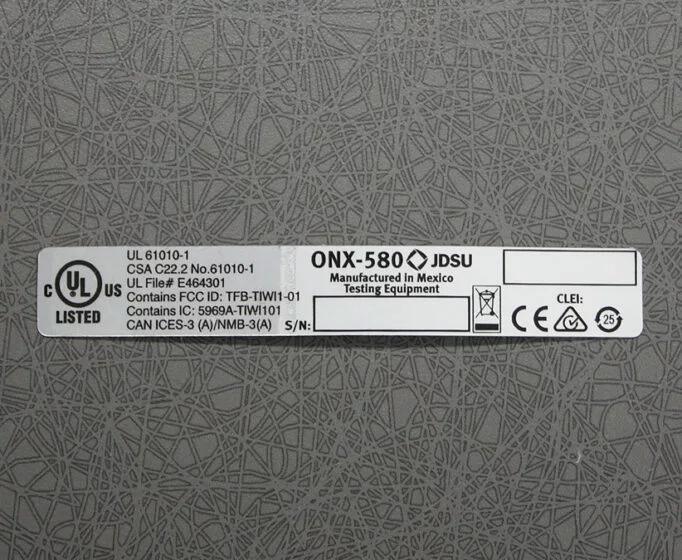
When printing the UL recognized component mark, it is the manufacturer’s responsibility to ensure the correct logo is used. This should be verified with a UL engineer. Additionally, there are three variations of UL’s Recognized Component Mark for different regions.
 Recognized Component Mark for the United States
Recognized Component Mark for the United States
 Recognized Component Mark for Canada
Recognized Component Mark for Canada
 Recognized Component Mark for the United States and Canada
Recognized Component Mark for the United States and Canada

UL 969 covers marking and labeling systems, with labels pre-qualified and tested by UL for durability. The certification process involves testing for weathering, adhesion, and suitability for different application surfaces and conditions.
When label manufacturers want to get their labels and markings certified, there are four general certification steps for them to follow:
Label manufacturers should note that printers may not substitute materials or printing methods once their labels are certified because it weakens the integrity of the certified label.
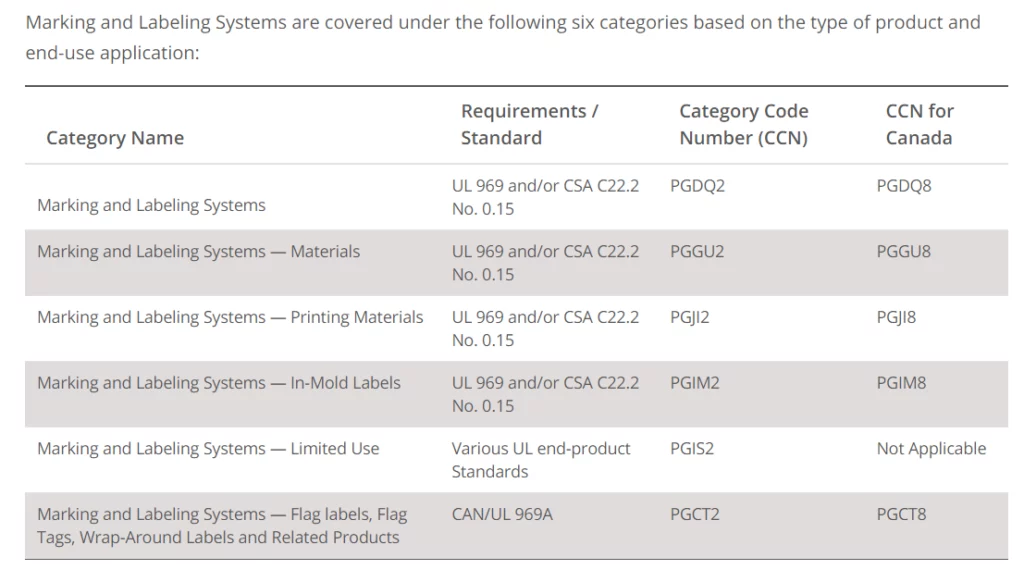
Screenshot via UL Solutions
Marking and labeling systems are covered in one of five categories, which vary by type of product and end-use application. Labels and label materials that fall into the first four category code numbers (CCN) — PGDQ2, PGJI2, PGIM2, and PGGU2 — are tested using the test methods in UL 969 Marking & Labeling Systems and are appropriate for use on a broad range of UL-Certified products. Because labels in the category code PGIS2 are considered limited use, they are evaluated using unique label requirements for specific UL-certified products.
The categories are as follows:
PGDQ2 is the highest level UL certification for labels, requiring that manufacturers get the adhesive, base material, printing, system, and lamination approved as a complete system. This standard typically applies to warning, danger, and caution labels that must remain legible for the product’s lifecycle. 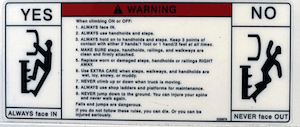
PGJI2 is the UL certification level for blank labels printed on thermal printers. Typically, these labels are printed by the OEM in their facility at the time of manufacture. At this certification level, the label material and the thermal ribbon must be tested for compatibility as a complete system.
PGIM2 is the UL certification that covers finished printed labels that are bonded to plastic surfaces during plastic-molding processes. The in-mold labels are appropriate for the molding process, generic plastic surface, and environmental use conditions and are intended to provide warnings, instructions, or other information that should be permanently marked on products.
PGGU2 is a certification that requires only the UL certification on the material. Label suppliers do not need to do any additional testing to their labels. Typically, labels in the PGGU2 certification are informational in nature and are not warning, caution, or danger labels.
PGIS2 covers cord tags and placards that are evaluated for complying with requirements in specific UL end-product standards when the performance requirements are less stringent or differ from those in the UL 969 Marking and Labeling Systems. Labels falling into the PGIS2 category typically are products like enclosures for electrical equipment, power supply cords, and gate operators.
The most recent updates to UL 969, the 5th Edition dated May 9, 2023, include several key requirements for marking and labeling systems:
Manufacturers must choose labels capable of meeting all these specifications – materials able to withstand exposure to the hazards specified in UL 969. Metalphoto® is one label material that holds up well to such conditions, exhibiting “no softening, staining, or noticeable fade after 24-hour exposure to: JP-4 fuel, Gasoline, Mineral spirits, Methyl ethyl ketone, Turpentine, Turbine & jet fuel, Kerosene, Xylol, Acetone, Toluol, Heptane, Trichlorethylene, MIL- H-5606 hydraulic fluid, and MIL-L-7808 jet engine oil.”
UL94 and UL969 are standards set by Underwriters Laboratories (UL) for different purposes.
UL94 is a standard for the flammability of plastic materials, focusing on how they burn in various orientations and thicknesses. It categorizes materials based on how they extinguish flames.
UL969, on the other hand, pertains to labeling and marking systems. It sets guidelines for the performance of labels, including their adhesion, legibility, and resistance to environmental factors like humidity, light, and heat.
A UL Category Control Number (CCN) is a unique identifier assigned to a product or product category by UL. It helps in identifying the specific UL requirements that apply to a product. This number is used internally by UL for listing and classification purposes and is often found on the UL certification or listing mark.
A UL label typically needs to include specific information such as the UL mark, the manufacturer’s name or trademark, a unique product identifier, and the UL file number. It may also require information about the product’s ratings, such as voltage or temperature. The label must be durable and legible, able to withstand the environmental conditions to which the product will be exposed.
UL listing rules are detailed guidelines and standards that a product must meet to be UL listed. These include safety tests, material evaluations, and performance criteria specific to the type of product. The rules vary depending on the product category and are designed to ensure that listed products meet high safety standards.
Whether a product needs a UL mark depends on the product type and its intended use. Products that involve electrical components, potential fire hazards, or are used in critical systems often require UL certification to be sold or installed in certain jurisdictions. However, not all products require a UL mark; it’s typically necessary for products where safety is a concern, as determined by industry standards, regulatory bodies, or the market.
Our sales engineers are experts in automatic asset tracking, tagging and identification,a nd can answer all your questions. Get in touch now.
Lets Talk ›